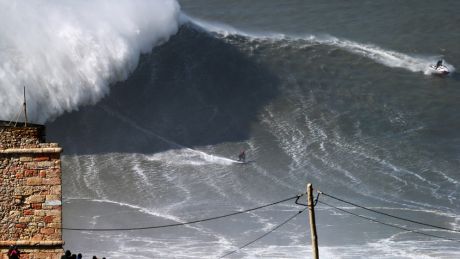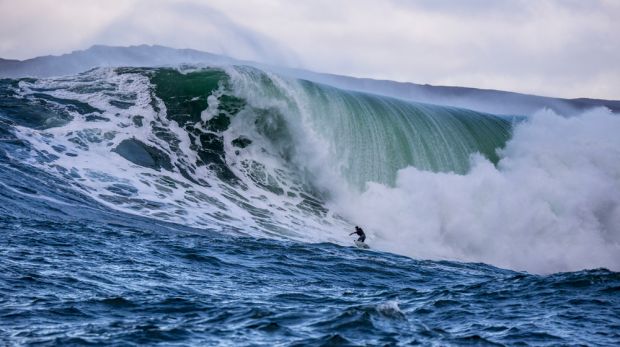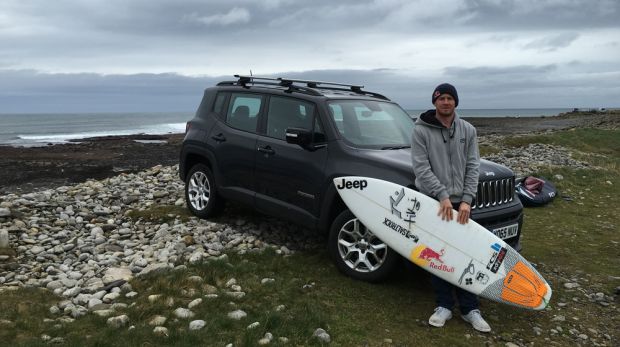Surfer Andrew Cotton On The Wave That Changed Everything For Him
What it was like to ride one of the biggest waves anyone has attempted to surf, and what happened next

On February 2, 2014, Andrew Cotton, then 34, modest to a fault and a dead ringer for the footballer Kasper Schmeichel, was not entirely happy with how life was unfolding.
He had been working as a part-time plumber in Devon with a spot of life-guarding thrown in, but his real passion was big wave surfing, a taste sufficiently expensive for him to require the funding assistance of sponsors.
Except the economic weather patterns were such that those sponsors had recently abandoned him. Unless something changed fast, his dreams of making a career standing up to the ocean’s most towering and violent waves would dissolve into a future confronting the less thrilling challenges of Worcester boilers, uncooperative toilets and building-site banter.
Thanks to a geological freak of nature, the little town of Nazaré on Portugal’s Atlantic coast is a big wave surfer’s fantasy. A shelf just a few metres off the coast plunges down hundreds of feet, like an underwater cliff, forcing the muscular swells rolling in from the ocean into monstrous waves as they shove up against it. Together with old waves washing back from the cliffs above the water line, this immense force can generate superwaves of 80ft and more, and all close enough to the shore to provide cliff-top spectators with a ringside seat.

“It was quite cold, stormy, and the sea was the biggest I’ve ever seen it,” recalls Andrew of the day in Nazaré when his life changed. They headed out in a group of five on three jet skis, a tow from a jet ski being the only way for a surfer to generate sufficient speed to surf down the waves.
“It was far from inviting or perfect, and it was quite windy. But we had a chat and knew that one of us would get a massive wave. We knew we had to be choosy…. Wait for the sort of wave we wanted.”
With impeccable patience and connoisseurship, after five hours they had only deemed one wave worth surfing. “Then a set (of waves) came up the canyon and you get the sort of wedging peaks that are a bit thicker and bigger,” says Andrew. “Garrett (McNamara, the current big-wave world record-holder) was driving the ski and I was in the water on my surfboard. I remember the second he started skiing, I felt, ‘That’s it, I’m committed. There’s no going back.’”
Get the Coach Newsletter
Sign up for workout ideas, training advice, reviews of the latest gear and more.
The wave turned out to be one of the biggest anyone had ever attempted to surf. “He drives me into the wave and I sort of water-ski behind him. Once I’ve matched the speed of the wave I let go of the rope, the ski drops off to the side and I surf,” Andrew recalls.
“It was fast, bumpy and hard to control, but I almost felt it in slow motion. I remember going down and down and thinking ‘I am never going to reach the bottom of this...’”
The wave was measured at about 80ft high, and would have been a world record were it not for a nit-picking technical imperfection: “I fell off.”
If you watch the footage on YouTube, though, you will see a heroic speck slicing its way almost vertically down the face of the wave for a few seconds, before the breaking white water hunts him down and engulfs him.
“It felt like about 20 minutes before the white water reached me, although it was pretty much instant, and I just couldn’t go fast enough. The line I chose committed me to go straight down rather than slightly to the right and I never got to the bottom. Or just as I got to the bottom, I got hit.”
As soon as he went under he pulled his inflatable vest “and then it was just like getting rag-dolled – a lot of water and a lot of impact.” Back on dry land and his senses recalibrated, his first thoughts on the experience were of disappointment.
“I’d travelled all that way to Portugal and I only caught one wave. OK, it was massive, but it wasn’t what I was looking for. Some of my friends had gone to Ireland to surf the same swell and the waves weren’t as big, but they were a bit cleaner, a bit nicer so I was thinking I’d made the wrong call. And I wish I hadn’t fallen off.”
While Andrew was exploring his bruises, though, footage and photos of his five-second ride were fizzing around the world, featuring in national newspapers and television bulletins the following day. “My life changed 100% because of it,” he says. “That one wave gave me global recognition, not just in the surfing world but in the mainstream press.”
The exposure brought fresh sponsors, such as Jeep, eager to be associated with something that no one could choreograph or stage. “They want to be attached to the things that I want to do, adventure, surf big waves, putting things on the line, doing things not the norm.”

The digital audience has also shown no sign of tiring of videos of the tiny man on the obscene wave, and the various revenues such magic produces means Andrew is now free to travel the world in search of bigger waves to conquer.
At 37, he feels his career is just beginning. Of course, on the day Coach travelled to Nazaré, the sea was as calm as a pint of Guinness. Still, Andrew kindly provided a jet ski tour of the scene of his greatest hit, and advice for others contemplating abandoning a career in plumbing in order to follow their dream: “Just don’t give up. Make decisions but not reckless decisions. If you do it for the right reason then things tend to work out,” he says.
The tour also took in a sinister, sharp-edged cave at the foot of the cliffs, one that a helpless surfer could be swept into and trapped, in nature’s equivalent of an iron maiden. “How would you escape from that?” Coach wonders. “I don’t think you would,” says Andrew grimly, and jet skis us out of there as fast as he can.
Andrew Cotton is a Jeep ambassador (jeep.co.uk). Coach flew to Lisbon with TAP (flytap.com).

Ed Needham was the founder and editor-in-chief of Coach magazine, a free health and fitness magazine published between 2015 and 2016. He now edits the magazine Strong Words.
